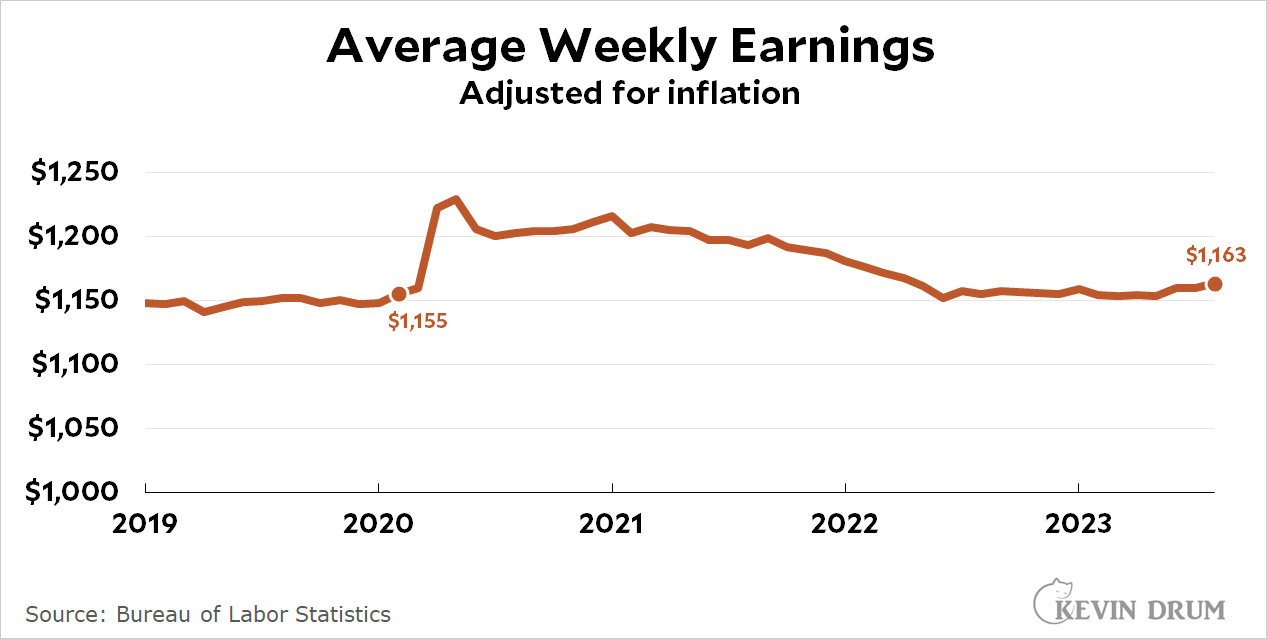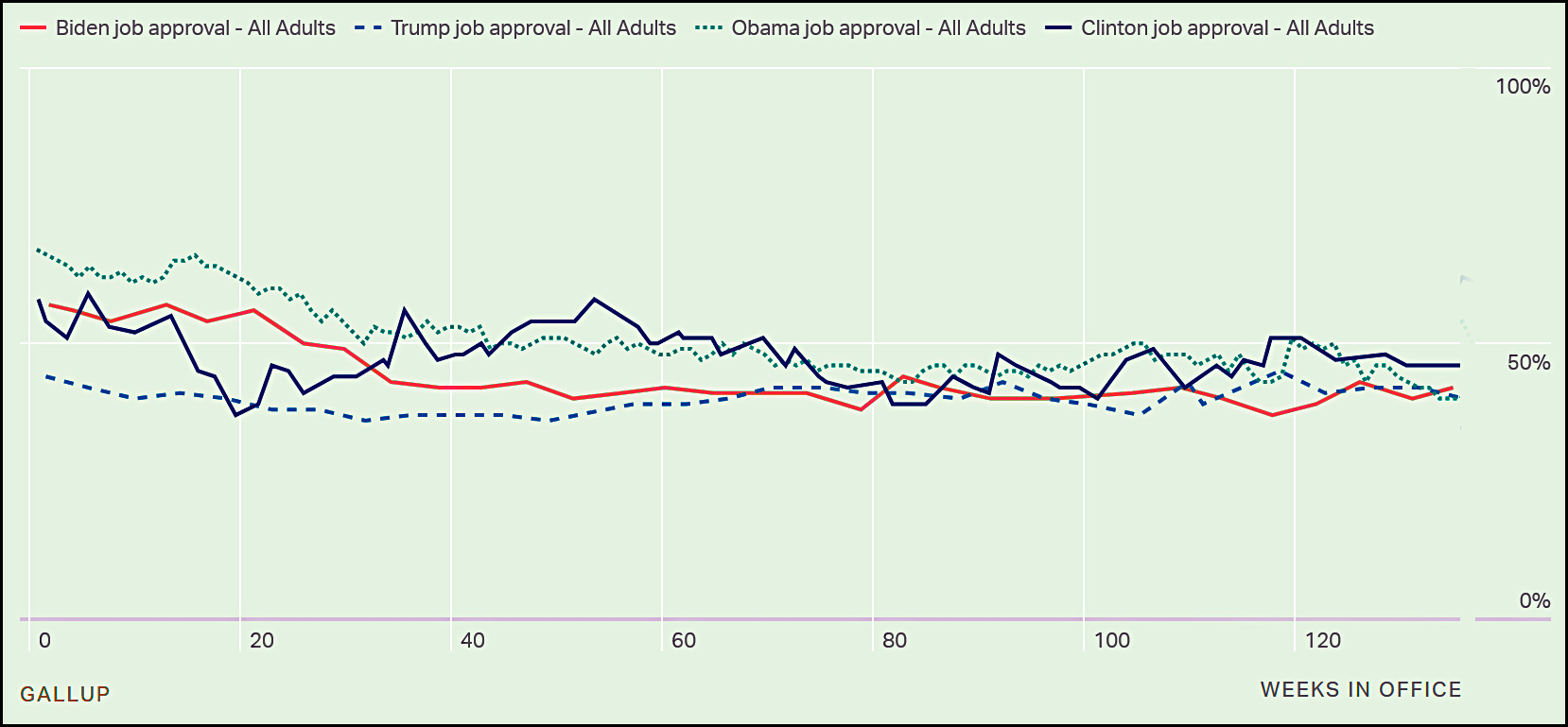Last week I showed you Hilbert rolling around, so this week you get a picture of Charlie rolling around. This is one of his (many) favorite spots, up on a cabinet in our kitchen where he can keep an eye on us and stay near the food bowl. A tummy rub is all it takes to make this absolutely perfect.
We can fix all our problems for 2.7% of GDP
I happened to come across some whinging about federal spending earlier this morning and it prompted me to draw this chart:
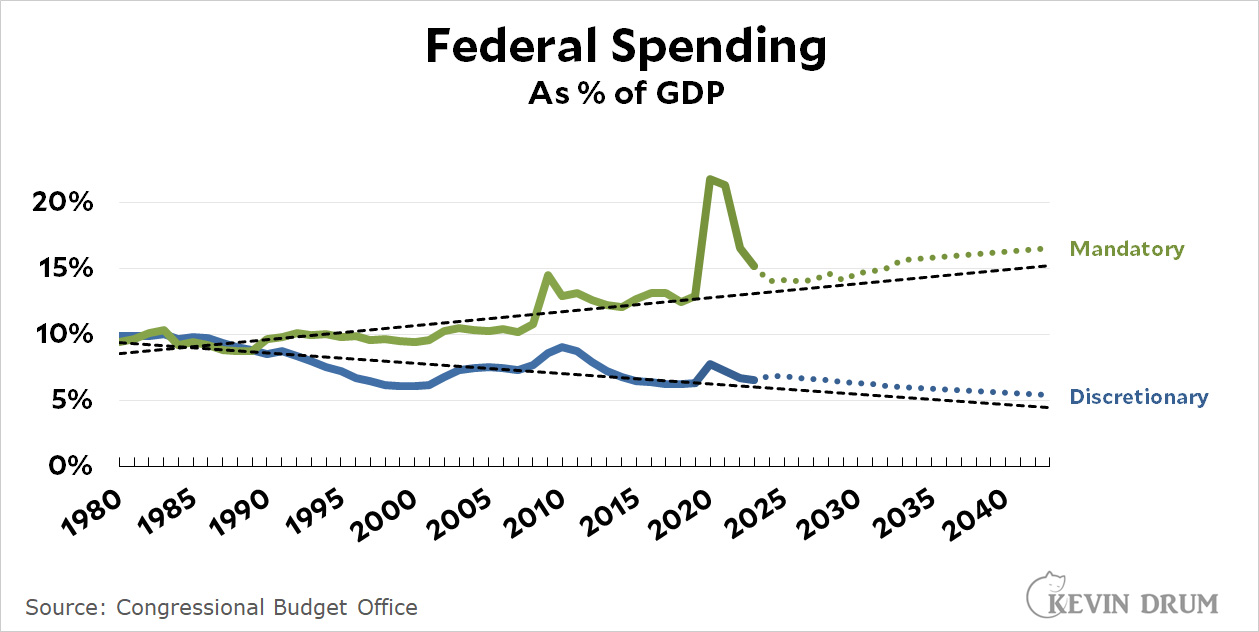 This is all the spending we have control over. Mandatory spending is mostly Social Security and Medicare but contains a chunk of other stuff too. Discretionary spending is defense and domestic spending that's appropriated on a yearly basis.
This is all the spending we have control over. Mandatory spending is mostly Social Security and Medicare but contains a chunk of other stuff too. Discretionary spending is defense and domestic spending that's appropriated on a yearly basis.
Between 2019 and 2043, CBO projects that discretionary spending will decrease by 0.9% and mandatory spending will increase by 3.6%. That's a total increase of 2.7% of GDP.
This is nothing new. Despite all the kvetching from Freedom Caucus Republicans over discretionary spending, it's been going steadily down since 1980 and will keep going down. That's not a problem. Mandatory spending, by contrast, has been going up, but we've known all along that it will keep going up. Social Security will keep increasing as baby boomers retire, peaking in 2034 and then staying steady after that. Medicare will keep increasing through around 2050, partly because of baby boomer retirement and partly because medical costs grow faster than inflation.
In any case, this has been in the cards forever and there's nothing much to be done about it. Discretionary spending is already declining and both Social Security and Medicare are wildly popular—and in a democracy that means there's little chance of cutting them back. So if we want to stabilize deficits it means increasing taxes by about 2.7% of GDP—or maybe a little more if you want to reduce deficits. That's not really very much, and of course it would stabilize projected interest expenses too.
That's all it would cost us to fix our budgetary problems more or less forever. It's too bad Republicans refuse to allow it.
Abortion is legal in California. Texas zealots need to get over it.
This is completely ridiculous:
More than a year after Roe v. Wade was overturned, many conservatives have grown frustrated by the number of people able to circumvent antiabortion laws — with some advocates grasping for even stricter measures they hope will fully eradicate abortion nationwide.
That frustration is driving a new strategy in heavily conservative cities and counties across Texas. Designed by the architects of the state’s “heartbeat” ban that took effect months before Roe fell...[new ordinances] make it illegal to transport anyone to get an abortion on roads within the city or county limits. The laws allow any private citizen to sue a person or organization they suspect of violating the ordinance.
Roulette and craps are illegal in California, but it's not illegal to drive someone to Las Vegas to play. Why, we even allow Las Vegas to advertise here in order to lure people into activities that are illegal in California.
This is universal in a country where freedom of movement is guaranteed and the Constitution says "Full Faith and Credit shall be given in each State to the public Acts, Records, and judicial Proceedings of every other State." Texas may not like the fact that abortion is legal in California, but that's tough. The Supreme Court says every state can decide for itself, and the Constitution says other states have to respect that. But there's a problem:
While these restrictions appear to violate the U.S. Constitution — which protects a person’s right to travel — they are extremely difficult to challenge in court, said Mary Ziegler, a law professor at the University of California at Davis who focuses on abortion. Because the laws can be enforced by any private citizen, abortion rights groups have no clear government official to sue in a case seeking to block the law.
This needs to go to court right quick anyway. Someone has standing and someone can be sued, even if no one has yet tried to enforce the law. I know that deputizing private citizens for enforcement is the latest hotness from too-clever-by-half Republicans, but I don't think even crackpot judges like Matthew Kacsmaryk or James Ho would have the balls to uphold statutes like this. Texas abortion fanatics may want to "build a wall" against "abortion traffickers," but they can't. End of story.
Weekly earnings rose 4.3% in August
High interest rates are about to hit the economy
The Wall Street Journal has a good roundup of higher interest rates today:
The Federal Reserve’s federal-funds rate averaged 0.5% from 2009 through 2021. Today it is between 5.25% and 5.5% and markets think it will be around 3.5% for the next decade. As yet, this has caused little distress. Growth is chugging along, and even the interest-sensitive housing sector seems to have a second wind.
The effects will come; just wait.
The whole piece is worth a read. It goes through households, commercial borrowers, real estate, and other segments of the economy and explains how high interest rates are slowly but surely having an effect. It's a very ground level view of how and why interest rate hikes take a while to work their way through the economy.
They haven't yet, but they will. Just wait.
Chart of the day: Net new jobs through August
The American economy gained a meager 187,000 jobs last month. We need 90,000 new jobs just to keep up with population growth, which means that net job growth clocked in at an even more meager 97,000 jobs. The headline unemployment rate increased to 3.8%.
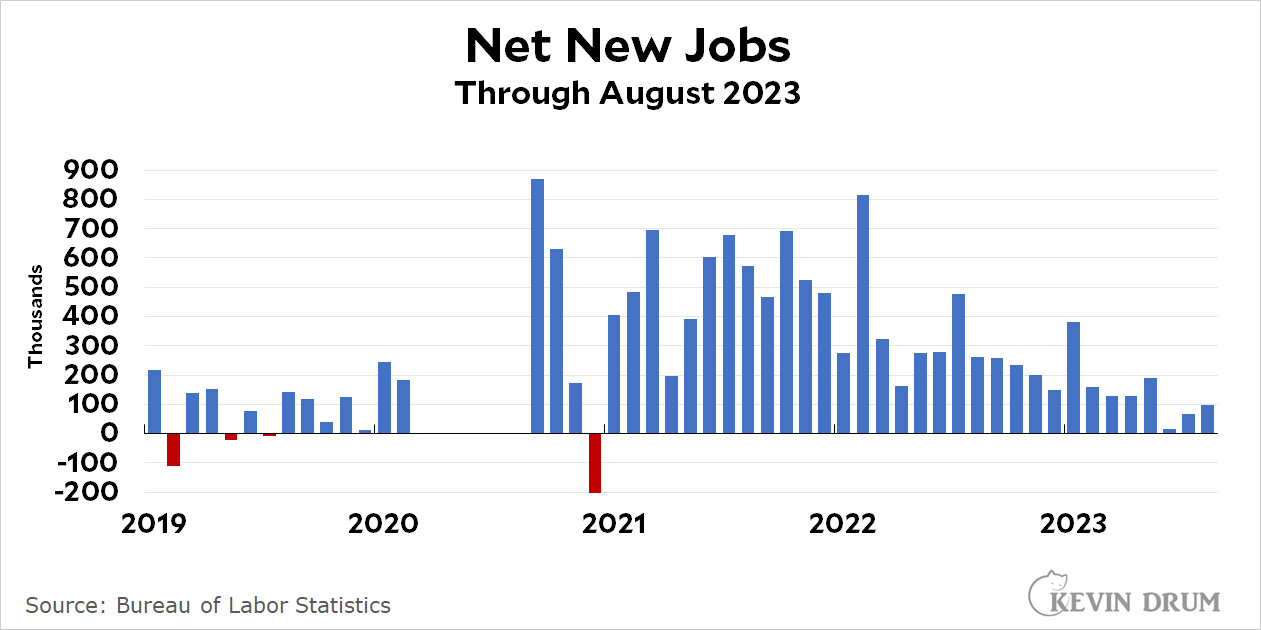 Unemployment rose by 514,000, most of them people who entered the labor force but don't yet have jobs. In addition the employment numbers for June and July were revised downward by a combined 110,000.
Unemployment rose by 514,000, most of them people who entered the labor force but don't yet have jobs. In addition the employment numbers for June and July were revised downward by a combined 110,000.
This is not a good report.
UPDATE: I originally reported that 525,000 people dropped out of the labor force, but I got the sign backward. Actually, 525,000 people entered the labor force in August.
Raw data: Joe Biden’s job approval at the end of August
Child care is no longer an emergency
A looming child care funding crisis threatens Biden’s economic recovery
Nearly $24 billion in federal aid for daycare centers and preschools is slated to run out Sept. 30, roiling a child care system that has underpinned the White House’s efforts to stabilize the broader economy and get people back to work.
....Daycare and preschool prices remain stubbornly high....Those costs — which typically run families more than $10,000 a year on average — are now likely to creep higher as child care programs compensate for the drop-off in federal aid, hitting American parents already fixated on the increase in everyday expenses. One projection widely circulated among Democrats estimates the funding expiration could boot as many as 3 million children from their programs, costing families up to $9 billion in total annual earnings.
....“It’s going to be really unfortunate timing,” said Whitney Pesek, director of federal child care policy at the National Women’s Law Center. “Child care prices are going to be going up heading into the 2024 election, when everyone’s running on the economy.”
This stuff annoys me. The whole point of this federal aid was to help out child care centers that were in danger of going out of business during the pandemic. That's it. Now the pandemic is over and parents have sent their kids back to day care:
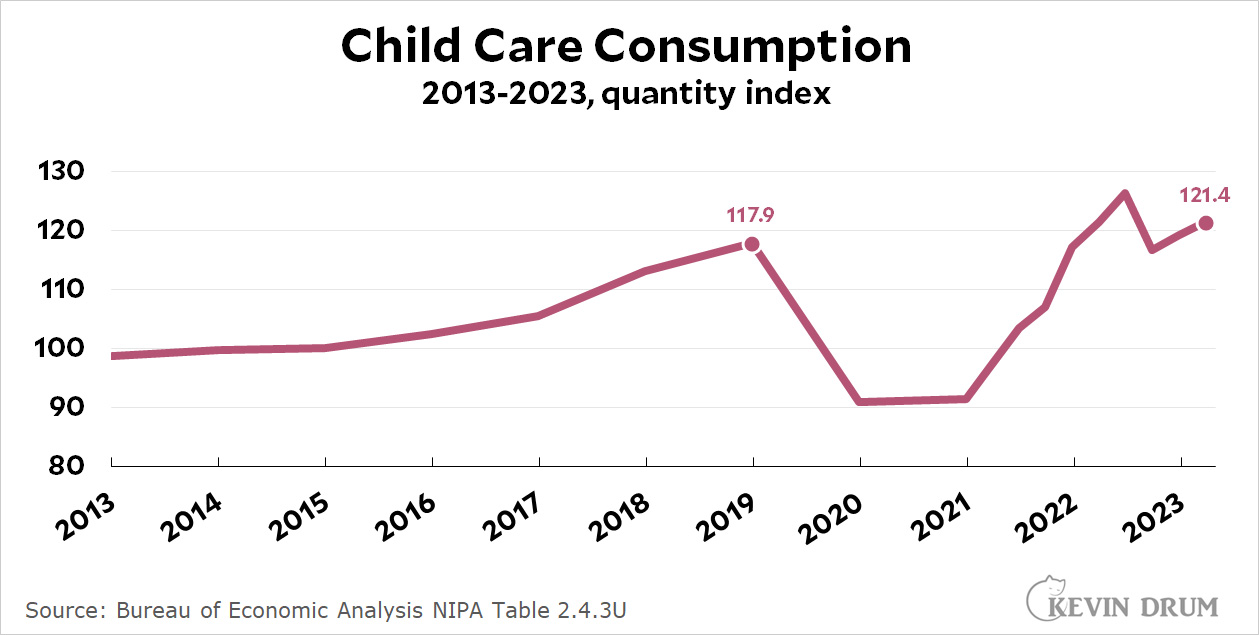
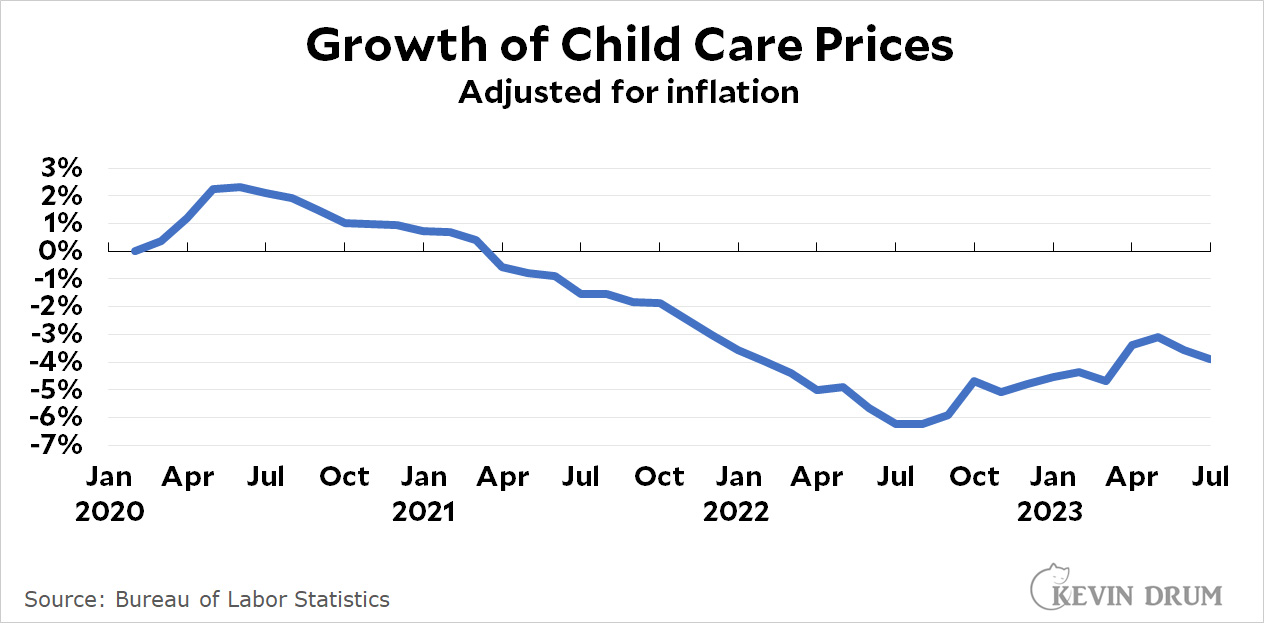 Some things are meant to be permanent forms of social welfare, like food stamps or Medicaid. But loans and grants to child care centers hit by a natural disaster aren't, and there's no reason to claim that this is a uniquely "bad time" to end it. The pandemic is over, kids are back, parents are working, the cost of child care is down compared to the start of the pandemic, and the economy is in good shape. Child care centers are in pretty much the same position they were in three years ago, so there's no reason at all to think that child care costs will suddenly spurt upward. What could possibly be a better time?
Some things are meant to be permanent forms of social welfare, like food stamps or Medicaid. But loans and grants to child care centers hit by a natural disaster aren't, and there's no reason to claim that this is a uniquely "bad time" to end it. The pandemic is over, kids are back, parents are working, the cost of child care is down compared to the start of the pandemic, and the economy is in good shape. Child care centers are in pretty much the same position they were in three years ago, so there's no reason at all to think that child care costs will suddenly spurt upward. What could possibly be a better time?
Everyone is getting less religious in America
Ramesh Ponnuru points to a new piece by Lyman Stone that says the decline of religion in America is mostly among the young. In fact:
Most of the decline in religion is actually among children, and virtually all of it among people under age 22.
This is crazy. Stone presents a whole bunch of charts that are limited to teens but ignores the easiest source of data around: the General Social Survey, which has asked about religious beliefs since 1972 and breaks everything down by age. Then, when he does finally get around to the GSS, he shows only the data for belief in God. But here's the growth of people saying they have "no religion." Nothing much happened in the '70s and '80s, but then secularization took off:
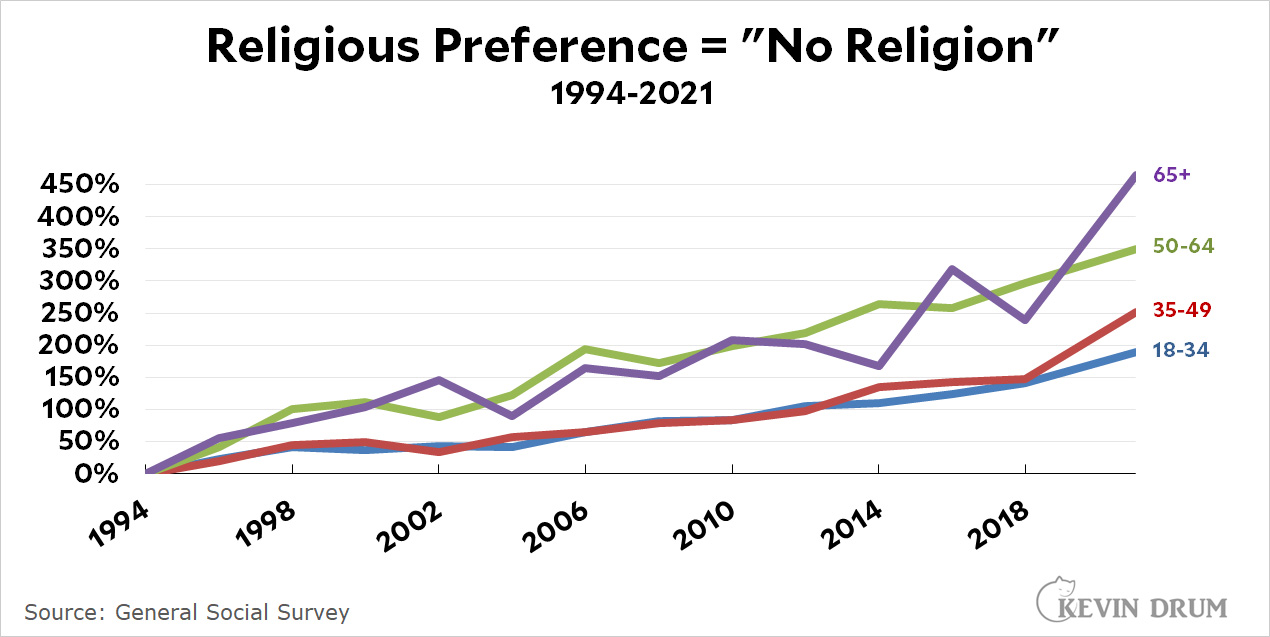 In absolute numbers, young people have always been less religious than older people. In 2021 twice as many young people declared no religion as did the 65+ age group. But in 1994 it was nearly five times as many. Secularization has grown far more among the old than the young.
In absolute numbers, young people have always been less religious than older people. In 2021 twice as many young people declared no religion as did the 65+ age group. But in 1994 it was nearly five times as many. Secularization has grown far more among the old than the young.
Here is church attendance:
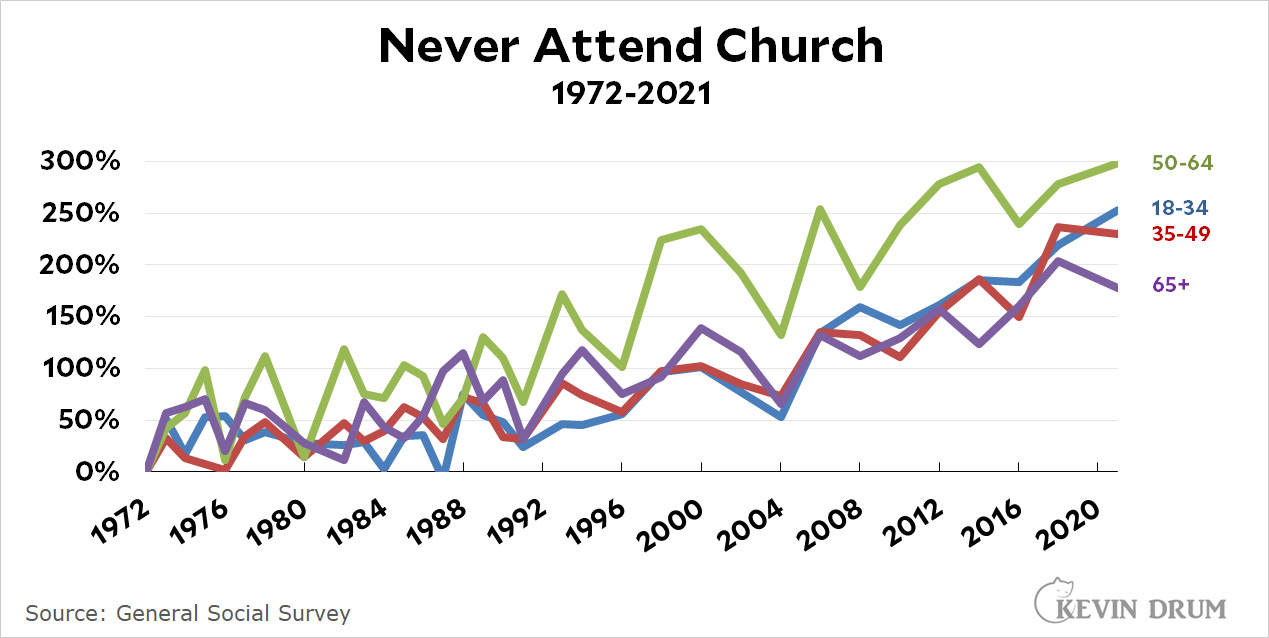 Church attendance has been declining ever since 1972. In this case secularization has grown most strongly among the middle-aged, and there's not a big difference between young and old. The number of people who never go to church has tripled or more among every age group.
Church attendance has been declining ever since 1972. In this case secularization has grown most strongly among the middle-aged, and there's not a big difference between young and old. The number of people who never go to church has tripled or more among every age group.
Stone's biggest point is that secularization starts in childhood. I imagine this is more or less true, but I can't say the data really backs it up. The number of older adults who are non-religious has gone up about 5x since 1994, and these are people whose childhoods were in the '50 and '60s—or even earlier. This is long before any countercultural secularization was in play. An awful lot of the decline in religion has happened among full-grown adults.


